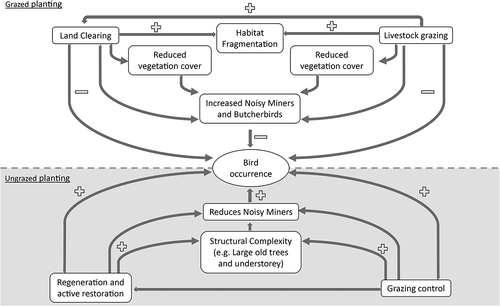Figures & data
Figure 1. Map of the location of long-term studies of birds in temperate woodlands of south-eastern Australia. Across these large-scale studies, a total of 872 sites (each comprising a 200 m transect; see ) have been surveyed repeatedly on an annual and biannual basis for between 12 and 23 years.

Figure 2. Conceptual model of the drivers of change in the presence and/or assemblage composition of temperate woodland birds in south-eastern Australia and approaches to mitigate (and potentially reverse) those declines. The top part of the diagram illustrates how the interacting processes of land clearing and grazing can lead to habitat loss and habitat fragmentation and can have direct effects on bird site occupancy or their impacts can be mediated through influences on populations of competitors and predators such as the Noisy Miner and the Grey and Pied Butcherbird (Westgate et al. Citation2021b). The bottom part of the conceptual diagram illustrates the direct and indirect effects of revegetation and grazing control on bird occurrence. Note that attempts to reduce fragmentation by directly connecting patches of native vegetation have not been illustrated as the effects on birds of boosting connectivity relative to simply increasing the amount of vegetation cover remain unclear (Lindenmayer et al. Citation2020a).

Table 1. Summary of six large-scale, long-term studies maintained by The Australian National University in which sites were surveyed repeatedly for temperate woodland birds with the aim of determining the impact of land use changes and management interventions on avian biodiversity.
